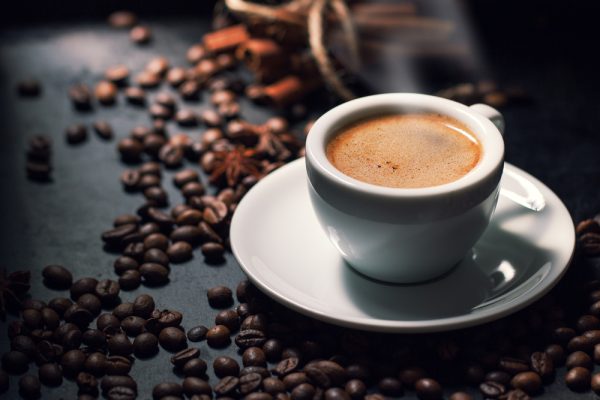Espresso has a high concentration of caffeine packed into a small punch. Not only does it have an intense coffee taste and a strong aroma, but the consistency is thick like maple syrup and the flavor is rich. Essentially, it’s a coffee enthusiast’s dream crammed into a convenient 1 oz shot.
Although dark roast coffee beans are generally preferred when making espresso, any kind of coffee bean can be ground down fine enough to be used when brewing an espresso shot. The flavor and other characteristics of espresso can differ greatly depending on how the coffee beans are processed. An example of this difference can be understood when comparing blonde espresso to regular espresso.
Let’s Compare the Beans
In a nutshell, blonde espresso is made with lightly roasted coffee beans. Traditional espresso, on the other hand, is typically made with medium-dark to dark-roast coffee beans. Although it may not seem like much, the level at which coffee beans are roasted directly impacts the brew that they will create.
Even where the coffee beans are grown and harvested can influence taste. Everything from the level of acidity, flavor, aroma, and appearance of the beans differ greatly when comparing blonde roasts and dark roasts.
Light Roasted Beans
Light roasts are typically produced in Latin America and east Africa. When the beans are processed, they are roasted at a temperature somewhere between 350°F to 400°F for up to 10 minutes. This is done for a short amount of time until the coffee beans start to crack open.
The initial crack, which indicates that moisture is starting to be removed, is generally when the roasting process is stopped. Unlike other types of coffee beans, light roasts don’t get heated past this first set of cracking. As a result, the beans are dense, still moist, and appear beige or pale brown in color.
Dark Roasted Beans
Darker roasts tend to come from Latin America, Asia, and the Pacific Islands. When the coffee beans are processed, they are roasted at a temperature somewhere between 465°F to 480°F for approximately 15 minutes.
Unlike light-roasted beans, dark-roasted beans are light, oily, and shiny. Not only do the beans lose some of their mass during the roasting process, but they also expand, making them slightly larger than lightly roasted beans. When they are done being processed, dark-roasted beans are an intense brown or almost black color.
Let’s Get Grinding
When it comes to grinding the beans into the fine, almost powdery consistency for brewing espresso, light roasts are more difficult. Due to the short roasting time, light-roast beans are denser. This results in a longer grinding time than dark-roast coffee beans.
Let’s Compare the Espresso Shots
Now that we have explored the difference in the beans after being roasted, it’s time to look at the espresso shots that are created with each bean. When comparing blonde espresso with traditional espresso, many differences can be observed.
Flavor, Aroma, & Caffeine Content
Blonde espresso, which is often described as being mild, smooth, and subtly sweet, has a wonderful citrus and floral fragrance. Typically, one blonde espresso shot contains 85 mg of caffeine.
Traditional espresso offers a flavor that is often described as being bold, bitter, and rich, with an aroma that is earthy and smoky with notes of cocoa. Although the caffeine content can vary, one shot of espresso averages 75 mg of caffeine.
Acidity & Strength
Due to the processing of the coffee beans, blonde espresso is slightly more acidic than traditional espresso. Blonde espresso has a pH level near 4.5, whereas regular espresso has a pH level closer to 5.5 or even 6.
When looking at caffeine, blonde espresso is considered stronger than traditional espresso. On the other hand, traditional espresso is stronger if you are just comparing flavor. For this reason, the idea of one being “stronger” than the other can be left up to your own interpretations depending on what you are comparing.
Additives
Due to its mild nature and subtly sweet taste, blonde espresso pairs well with almond milk and vanilla syrup. Traditional espresso, with its bitter and bold flavor, can pair well with honey, cinnamon, chocolate syrup, and various milk products.
Is There a Healthier Choice?
Since blonde espresso is roasted for a shorter amount of time, it has more antioxidants than traditional espresso. For this reason, some consider it to be healthier. On the other hand, blonde espresso also contains slightly more caffeine and more acid, which could be unsettling to the stomach. So, in theory, it is hard to distinguish which is better.
Nutritional Values
Without the presence of any additives, a 1 fl oz shot of espresso contains less than five calories. This is still true regardless of what roast is being brewed. What does affect calories, carbs, sugars, and fats are the various add-ins that some people choose when enjoying espresso shots.
Choosing Between Blonde and Regular Espresso
If you are new to the espresso scene, many people suggest starting off with a blonde espresso. This is mainly due to the light roast coffee beans’ mild and sweet taste. Although blonde espresso contains more caffeine, it’s believed to provide a more satisfying experience for espresso amateurs.
If you consider yourself a coffee enthusiast and you love dark roast coffee, with its powerful and pungent flavor, traditional espresso may be more your style. Traditional espresso shots are bold, strong, and bitter and might be enjoyed more by people who enjoy these traits.
While neither type of espresso shot, made with different levels of roasted coffee beans, can be determined as healthier than the other, they both offer different flavors, aromas, levels of acidity, and caffeine contents. Not to mention that the whole bean looks different before being ground, and one type of roast is tougher to grind than the other.
Now that you are armed with all this information, it should be easier to choose which type you might prefer. The next step would be to try one of them out!

